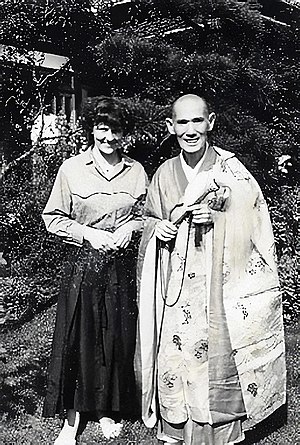Hakuun Yasutani
Hakuun Yasutani | |
|---|---|
 Yasutani Rōshi and Brigitte D'Ortschy | |
| Title | Rōshi |
| Personal | |
| Born | 1885 Japan |
| Died | 1973 (aged 87–88) |
| Religion | Japanese Zen |
| Nationality | Japanese |
| School | Sanbo Kyodan |
| Senior posting | |
| Predecessor | Harada Daiun Sogaku |
| Successor | Yamada Koun Taizan Maezumi |
Hakuun Yasutani (安谷 白雲 Yasutani Haku'un, 1885–1973) was a Sōtō rōshi, the founder of the Sanbo Kyodan organization of Japanese Zen.
Biography
Ryōkō Yasutani (安谷 量衡) was born in Japan in Shizuoka Prefecture. His family was very poor, and therefore he was adopted by another family.[1] When he was five he was sent to Fukuji-in, a small Rinzai-temple under the guidance of Tsuyama Genpo.[1]
Yasutani saw himself becoming a Zen-priest as destined:
There is a miraculous story about his birth: His mother had already decided that her next son would be a priest when she was given a bead off a rosary by a nun who instructed her to swallow it for a safe childbirth. When he was born his left hand was tightly clasped around that same bead. By his own reckoning, "your life ... flows out of time much earlier than what begins at your own conception. Your life seeks your parents.[1]
Yet his chances to become a Zen-priest were small, since he was not born into a temple-family.[2]
When he was eleven he moved to Daichuji, also a Rinzai-temple.[1] At the age of thirteen he was ordained at Teishinji,[1] a Sōtō temple and given the name Hakuun.[3] When he was sixteen he moved again, to Denshinji, under the guidance of Bokusan Nishiari.[1]
Thereafter he studied with several other priests, but was also educated as a schoolteacher and became an elementary school teacher and principal. When he was thirty he married, and his wife and he eventually had five children.[1]
He began training in 1925, when he was forty, under Harada Daiun Sogaku, a Sōtō Rōshi who had studied Zen under both Sōtō and Rinzai masters. Two years later he attained kensho, as recognized by his teacher. He finished his koan study when he was in his early fifties, and received Dharma transmission from Harada in 1943, at age fifty-eight.[4] He was head of a training-hall, but gave this up, preferring instead to train lay-practitioners.[1]
To Yasutani's opinion Sōtō Zen practice in Japan had become rather methodical and ritualistic.[5] Yasutani felt that practice and realization were lacking. He left the Sōtō-sect, and in 1954, when he was already 69, established Sanbō Kyōdan (Fellowship of the Three Treasures), his own organization as an independent school of Zen.[4] After that his efforts were directed primarily toward the training of lay practitioners.
Yasutani first traveled to United States in 1962 when he was already in his seventies. He became known through the book The Three Pillars of Zen, published in 1965.[6] It was compiled by Philip Kapleau, who started to study with Yasutani in 1956. It contains a short biography of Yasutani and his Introductory Lectures on Zen Training. The lectures were among the first instructions on how to do zazen ever published in English. The book also has Yasutani's Commentary on the Koan Mu and somewhat unorthodox reports of his dokusan interviews with Western students.[7]
In 1970 upon his retirement Yasutani was succeeded as Kanchõ (superintendent) of the Sanbokyodan sect by Yamada Kõun. Hakuun Yasutani died on 8 March 1973.[8]
Bibliography
- Yasutani, Hakuun; Jaffe, Paul (1996), Flowers Fall: A commentary on Zen Master Dogen's Genjokoan, Shambala, ISBN 1-57062-103-9
- Dōgen Zenji to Shūshōgi (道元禅師と修證義). Tōkyō: Fujishobō, 1943
See also
- Buddhism in Japan
- Buddhism in the United States
- Buddhism in the West
- Timeline of Zen Buddhism in the United States
Notes
References
Book references
- ↑ 1.0 1.1 1.2 1.3 1.4 1.5 1.6 1.7 Jaffe 1979.
- ↑ Ford 2006, p. 150.
- ↑ Kapleau 1989, p. 30.
- ↑ 4.0 4.1 Jaffe 1996, p. xxiv.
- ↑ Jaffe 1996, p. xxviii.
- ↑ "Zen Teaching, Zen Practice: Philip Kapleau and The Three Pillars of Zen". thezensite. Retrieved 25 July 2014.
First published in 1965, it has not been out of print ever since, has been translated into ten languages and, perhaps most importantly, still inspires newcomers to take up the practice of Zen Buddhism.
- ↑ Jaffe 1996, p. xxv.
- ↑ Sharf, Robert, H. (1995). "Sanbokyodan. Zen and the Way of the New Religions" (PDF). Japanese Journal of Religious Studies. 22 (3-4): 422. Archived from the original (PDF) on 25 September 2000.
Web references
Sources
- Ford, James Ishmael (2006), Zen Master Who?: A Guide to the People And Stories of Zen, Wisdom Publications
- Jaffe, Paul David (1979), Yasutani Hakuun Roshi — a biographical note
- Jaffe, Paul David (1996), Foreword. In: Flowers Fall: A commentary on Zen Master Dogen's Genjokoan, Shambala, ISBN 1-57062-103-9
- Kapleau, Philip, ed.and translator (1989), The Three Pillars of Zen, Doubleday, ISBN 0-385-26093-8
- McMahan, David L. (2008), The Making of Buddhist Modernism, Oxford University Press, ISBN 9780195183276
- Sato, Kemmyō Taira (2008), D.T. Suzuki and the Question of War (PDF)The Eastern Buddhist 39/1: 61–120
- Sharf, Robert H. (August 1993), "The Zen of Japanese Nationalism", History of Religions, 33 (1): 1–43
- Sharf, Robert H. (1995c), "Sanbokyodan. Zen and the Way of the New Religions" (PDF), Japanese Journal of Religious Studies 1995 22/3-4
- Victoria, Brian Daizen (2006), Zen at war (Second ed.), Lanham e.a.: Rowman & Littlefield Publishers, Inc.
- Yasutani, Hakuun; Jaffe, Paul (1996), Flowers Fall: A commentary on Zen Master Dogen's Genjokoan, Shambala, ISBN 1-57062-103-9
External links
| This article includes content from Hakuun Yasutani on Wikipedia (view authors). License under CC BY-SA 3.0. |